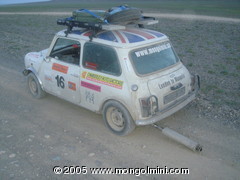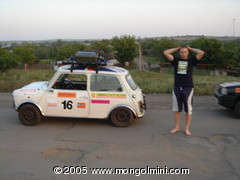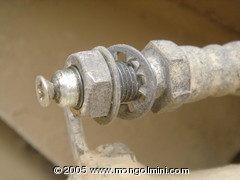|
You probably won't be surprised to hear that we had several problems en route. I don't think Sir Alex Ignosis had the foresight to consider the Mongol Rally when designing the Mini. The following describes the technical problems we had en route, roughly in the order in which they happened:
 The Exhaust was a nightmare. Problems first started in Poland with the back box exhaust bracket rattling lose. Temporary bodges kept us going to Kazakhstan, where we first pulled off the back box against a large rut. This happened a few more times in Uzbekistan, but in Mongolia it was a source of constant frustration. Multiple times daily we had to jack the car up to put the back box or middle pipe back on. Our final fix was to put the back box on the roof rack, but we still had to refit the middle pipe several times. Running an unsilenced exhaust for 10 hours a day is tough. Headaches and short tempers ensued.
The Exhaust was a nightmare. Problems first started in Poland with the back box exhaust bracket rattling lose. Temporary bodges kept us going to Kazakhstan, where we first pulled off the back box against a large rut. This happened a few more times in Uzbekistan, but in Mongolia it was a source of constant frustration. Multiple times daily we had to jack the car up to put the back box or middle pipe back on. Our final fix was to put the back box on the roof rack, but we still had to refit the middle pipe several times. Running an unsilenced exhaust for 10 hours a day is tough. Headaches and short tempers ensued.
 The modified suspension (as described above), was not up to the job. The fronts coped well, but the rears couldn't take abuse. The combination of the weight of fuel, tools and water and terrible roads was too much. First the large bolts used for adjusting the suspension bent (dropping the car two inches) and while getting airborne leaving a large crater in the Ukraine, one of the bolts snapped, dropping the suspension completely.
The modified suspension (as described above), was not up to the job. The fronts coped well, but the rears couldn't take abuse. The combination of the weight of fuel, tools and water and terrible roads was too much. First the large bolts used for adjusting the suspension bent (dropping the car two inches) and while getting airborne leaving a large crater in the Ukraine, one of the bolts snapped, dropping the suspension completely.
We managed to fix this by cutting down the snapped bolt, and putting washes into the setup to gain sufficient height to be able to drive. We made the washers with some copper pipe carried by The Rolling Johnstones team, and by cutting down the jack handle (which happened to be the perfect diameter). We got a more permanent fix in an oil rig machine shop in Kazakhstan. They made us three new bolts giving us a fix and some spares. Thanks to Jim at Caspi Down Whole Services!
We suffered a heater matrix leak in Russia, dropping boiling water onto our feet. Easily resolved using a bit of Rad Seal.
The rear suspension trailing arm gave us problems as well. Throughout the Ukraine and Russia we could hear a rubbing noise when cornering to the left. In Kazakhstan, an over exuberant hand brake turn left the right rear wheel rubbing against the inner wheel arch. Inspection showed the trailing arm to be moving laterally. We were able to get going by hammering the wheel arch out of the way.
 The following day (while waiting for our suspension bolts to be made) we took the rear right suspension apart. The pivot/thrust bearing in the trailing arm had disintegrated, allowing the movement the left the wheel fouling the arch. Once again we managed to bodge this but cutting some coper pipe into a type of shell bearing, and inserting this into the trailing arm.
The following day (while waiting for our suspension bolts to be made) we took the rear right suspension apart. The pivot/thrust bearing in the trailing arm had disintegrated, allowing the movement the left the wheel fouling the arch. Once again we managed to bodge this but cutting some coper pipe into a type of shell bearing, and inserting this into the trailing arm.
With the weight and terrible roads, the roof rack kept rattling itself loose and sliding backwards down the roof.
Punctures. Or perhaps that should read puncture. Despite the 3 spares we carried and two cans of instant puncture repair, we only suffered one puncture in the entire trip. Quite a contrast to some of the other teams. The Rolling Johnstones who were with us suffered 3 punctures in two days.
The heat in the desert was a problem. We actually only had to stop once due to over heating, but otherwise we had to put the heater on to draw heat away from the engine, and slow the pace down. Driving in a 45 degree desert with the heater on full isn't the most pleasant of experiences.
Minis are renowned for oil leaks, but one of the gearbox oil seals got progressively worse throughout the trip. It pains me to think of how much oil we had to put in to get there.
We had ignition problems in Kyrgyzstan. This was the problem that lost us most time in the trip. It started with the car miss firing while attempting to go up a 3000 metre mountain. Checking out the basics, showed the points to be covered in dust and not gapped correctly. With this resolved we got going again, but not for long. The problem was quite intermittent, but would always rear its ugly head once the car was hot.
We checked the HT circuit, and played with the timing. Sometimes this helped, but overall this was unsuccessful. We got towed back to a mechanic who found a bad connection in the coil HT lead, and re-adjusted the timing. This cured the problem for a couple of hours, but the following day this hit us hard again. Thankfully Jon spotted a loose wire, that had snapped from its connector. Turns out the wire eventually went to the condenser, which explains perfectly the symptoms encountered.
We had a bit of a worry with the engine moving backwards and forwards several inches. Thankfully this was just the stabaliser bar that had worked lose.
We had a misfire problem when driving in the rain that we never got to the bottom of. This did manage to stop us once, but a load of WD40 improved it sufficiently to get going again. Just as well we didn't encounter to much rain.
The brakes gave us serious problems. Due to Andy's incompetence at fixing them, we had to drive about 400km with no brakes at all. First off, the rear wheel cylinders were rattled lose from their mounts (only held on with circlips). This killed off the rear brakes and handbrake. Next, one of the metallic brake lines going into the rear cylinder snapped. This caused loss of fluid and pedal feel.
 We tried to bleed the system and then seal of the rear brake lines, but we were unable to draw any fluid to the rear pipes. This turned out to be due to the brake line that runs to the back of the car being crushed under the car. We had to cut this, bleed it and then seal it off.
We tried to bleed the system and then seal of the rear brake lines, but we were unable to draw any fluid to the rear pipes. This turned out to be due to the brake line that runs to the back of the car being crushed under the car. We had to cut this, bleed it and then seal it off.
We'd lost so much fluid that air had entered both brake systems, rendering the front brakes useless as well. This Mini's front / rear braking system split worked in our favor. After a lot of attempts we were able bleed the air out from the front, even with the rears completely disabled, regaining effective braking.
We suffered a radiator leak in Mongolia, losing a lot of water daily. We were able to buy some Rad Seal, which once again cured the problem, from a small shop in the middle of the Gobi Desert.
On the penultimate day, as we were nearing the finish, we were struck by two further suspension problems. The left rear suspension bolt snapped again. Luckily we had the spare made by our friends at Caspi Down Whole Service in Kazakhstan. Further to that, the rear left tyre was fouling the outer arch, giving off smoke and looking at though it was read to burst. Although unsure as to how the whole rear subframe appeared to have shifted to the left, we were able to get round this problem but playing about with the washers on the rear trailing arm. This shifted the wheel in several millimetres giving us enough clearance to make the finish.
If you've made it this far, you will have seen that this trip was by no means easy. Many people have asked us if we had any mechanical skills before setting off. The answer is yes we did. It is probable, in light of all the problems we had, that we wouldn't have made the finish if we weren't up to the job.
|